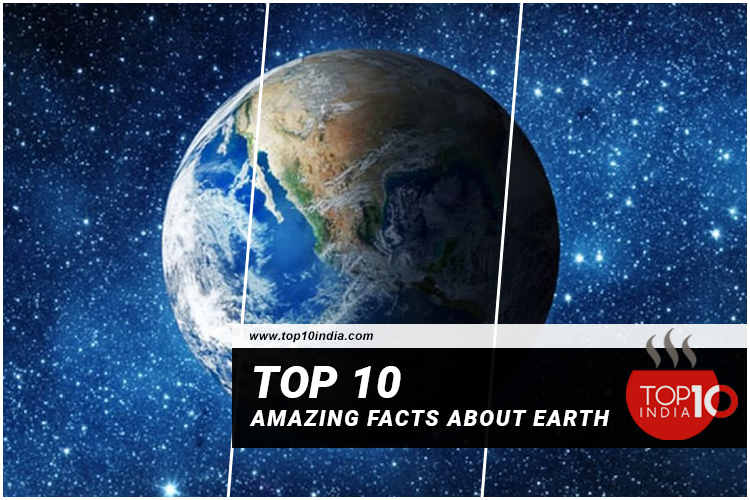Top 10 Amazing Facts About Earth: In the world, Mount Everest is not the tallest mountain is the number 1 fact about the earth; instead, Mount Kea is the tallest mountain. Earth is just like a shiny blue marble that has been fascinating to humanity since it first began to steer across its surface. Moreover, to be our sweet home and also the place where every life as we all know it originated, it remains the sole planet we all know of wherever life flourished.
Top 10 Amazing Facts About Earth
We live our lives on Planet Earth; however, we most likely have numerous amazing facts about earth rattling around in our brains. However, here are ten additional fascinating facts regarding Earth that we just might or might not grasp. Even Scientists believe there is still much more to learn about our planet. So here are the top 10 amazing facts about earth.
No 1. In the world, Mount Everest is not the tallest mountain
Yes, this is the unofficial truth. Mauna Kea, associated with a Nursing inactive volcano in Hawaii, is the world’s tallest mountain as measured from its base, deep within the ocean, to its summit.
- Mauna Kea’s summit is at 13,796 feet (4,205 meters) higher than the water level, so it extends 19,700 feet (6000 meters) below the water’s surface.
- Therefore, its total height is 33,500 feet (10,210 meters), nearly a mile taller than Mt. Everest, approximately 4,445 feet (1,355 meters) in keeping with the US Geological Survey (USGS). This makes it an amazing fact about the earth.
No 2. The days are getting longer
The length of Earth’s day is increasing. This is a fascinating facts about the earth to discuss. Once Earth was fashioned 4.6 billion years ago, its day would are roughly six hours long. By 620 million years ago, this had magnified to 21.9 hours.
- Today, the common day is 24 hours long. However, it is increasing by concerning 1.7 milliseconds each century.
- Earth’s spin causes the position of its recurrent event ocean bulges to be forced slightly earlier than the moon-Earth axis, which creates a twisting force that slows down Earth’s rotation.
- As a result, our day is obtaining longer, however shortly enough to distinguish our busy schedule.
No 3. The neighboring States can have 24 hours time difference
Even though American Samoa is only 1,240 Miles (2,000 KM) away from the Line Islands, Kiribati. The difference between the two neighbor’s time is 25 Hours.
- The International Date Line (IDL) passes in between American Samoa and the island of Samoa. It’s not a line following the Anti-meridian. Rather the IDL zig-zags around numerous island chains.
- This crookedness of the IDL is more increased thanks to daylight-savings time nowadays employed in many territories, shifting them an extra hour out of correct with the natural time.
No 4. Earth doesn’t take 24 hours to rotate on its axis
The time it takes for the world to rotate fully around its axis is 23 hours and 56 minutes, and 04 seconds. But the world is additionally orbiting the Sun, so by the time the world has completed one full spin on its own axis, the purpose nearest the sun has modified slightly.
So the time it takes for the sun to look within the same position within the sky is 24 hours.
- If we weren’t orbiting the sun, then an entire 360-degree rotation of the world would invariably finish with the sun within the same place within the sky daily.
- But since we tend to orbit the sun daily, we are a bit farther on our yearly path. Therefore, it takes 360 degrees of Earth’s rotation to bring the sun back to an hour daily.
No 5. A year on Earth isn’t 365 days
The Earth takes 365.24 days to complete a single rotation around the sun. A ‘day’ is outlined because the Earth is Spinning once on its axis. 8,765 hours, or 526,000 minutes, or 31.6 million seconds, is a single Earth year.
- To solve this, we put on extra days in some years, which are called or known as leap years.
No 6. In the past, Sea levels were very different
The most recent advance of ice on Earth began before 70,000 years, ended 11,500 years past, and reached its uttermost extent 18,000 years past.
Then the glaciers and sheets of ice engraved out the basins of the nice Lakes and blocked rivers, entertaining the courses of the Mississippi and alternative rivers within the U.S.
- As such, a lot of water was unfrozen as ice that ocean levels born by the maximum amount as 120 meters (390 feet), exposing components of what’s currently the Davy Jones’s locker.
- Earth’s water level has conjointly been up to seventy meters (230 feet) higher within the past.
- Throughout the last interglacial amount, the ocean was really five to seven meters (16 to twenty-three feet) beyond its nowadays.
No 7. Calm Before the Storm
As a storm attracts heat, wet air, fuel from the encompassing atmosphere, it leaves a nonaggressive space behind. Air is carried up into the cloud, and a few of it’s forced upwards by powerful drafts.
These updrafts take away the recent air and push it out over the perimeters of the best storm clouds, which might be up to sixteen kilometers (10 miles) high.
- Because the air then descends, it becomes hotter and drier and so additional stable. It blankets the region below and stabilizes the air, inflicting individuals to note peace before the storm. This makes it an interesting fact about the earth to discuss.
No 8. The many Moon’s of Earth
Technically, the planet has simply one moon. However, our planet has 2 orbital’s known as 3753 Cruithne and 2002 AA29, which are a part of a bigger population of asteroids named Near-Earth Objects (NEOs). It is among the Top 10 Amazing Facts About Earth.
The asteroid called 3753 Cruithne measures five metric linear units across and is typically known as “Earth’s second moon.”
It doesn’t truly orbit the planet; however, it contains a synchronous orbit with our home planet. However, it’s truly following its own distinct path around the Sun.
No 9. The Earth’s rotation is gradually slowing
This speed is occurring nearly unnoticeably, at roughly seventeen milliseconds per hundred years, though the speed at that it happens isn’t dead uniform.
- This has an impact on the continuation of days. However, it slowly happens that it may be the maximum amount as a hundred and forty million years before the length of every day can have increased to twenty-five hours.
- The day’s length varies slightly from year to year, as well, the results of myriad forces each on and off Earth pushing and actuation at its rotation.
No 10. Earth is the only planet that is not named after a God
The other seven planets in our scheme square measure all named once Roman or Greek gods or Goddesses. The Roman methodology of naming planets was maintained once the invention of Uranus and Neptune.
- Names of the planet in our system got their name as per Greek or Roman mythology.
- IAU adopted this ancient naming tradition for the planets and unbroken people’s names of planets as per ancient times.
- Furthermore, the planets that weren’t celebrated in classical times and discovered in fashionable times are too named after Greek and Roman Gods.
- The planet Earth is that the sole planet that isn’t named supported Roman or classical mythology.
FAQs
- What are 5 interesting facts about Earth?
5 interesting facts about Earth are-
- Mount Everest isn’t the tallest mountain in the World
- The days are getting longer
- Neighboring states have 24 hours time distinction
- Earth doesn’t require 24 hours to turn on its hub
- A year on Earth isn’t 365 days.
2. What is Earth’s real name?
Earth’s real or alternative names are Gaia, Tellus, the world, Terra, and the globe.
3. What is the most interesting facts about the earth?
The calm before the storm is the most interesting fact about the Earth.















Be First to Comment